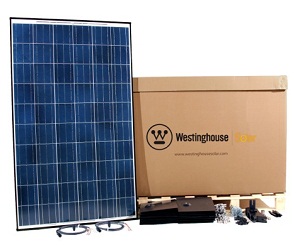Australia’s CDB Energy invests in Westinghouse Solar
 Westinghouse Solar’s all-in-one approach to AC photovoltaic modules, which includes a microinverter, racking, mounting and wiring, attracted a $1 million investment from Australian company CDB Energy. At the same time CDB made the investment, the companies announced that they will explore a further relationship that could bring Westinghouse Solar panels to the Australian market.
Westinghouse Solar’s all-in-one approach to AC photovoltaic modules, which includes a microinverter, racking, mounting and wiring, attracted a $1 million investment from Australian company CDB Energy. At the same time CDB made the investment, the companies announced that they will explore a further relationship that could bring Westinghouse Solar panels to the Australian market.
Currently, there aren’t any projects underway in which Westinghouse Solar’s modules are being used in Australia, according to Westinghouse Solar CEO Barry Cinnamon. But the investment may be the first step.
“This investment was made with the anticipation that there would be projects distribution and manufacturing [opportunities with them,” he said.
While solar exists in Australia, it’s still struggling to get a foothold since, like in the U.S., there’s no feed-in tariff.
The country’s solar incentive program has been in flux, according to Cinnamon.
“They, kind of, come and go. Ultimately what’s really important to us is getting into markets where electricity is expensive, and it’s sunny,” he said, which sums up Australia.
CDB Energy isn’t new to renewables.
“They’ve been doing rooftop solar installations. They have a very keen appreciation for reducing installation costs,” Cinnamon said.
Westinghouse Solar’s AC modules are designed for plug-and-play simplicity, which will help reduce installation costs. They’ll also likely be the first such modules on the market there.
“I believe it’s going to be new to the Australian market. The whole concept of microinverters is still very new throughout the industry, but it’s going to take off,” Cinnamon said.
Adding in all the other components, Westinghouse Solar is even newer to the industry and is only now gaining traction in the U.S. and starting to go international. The trend will become larger as the costs of solar modules stops falling and other costs remain stagnant.
“When modules were $4 a watt, no one cared that is was $1.50 a watt to install solar,” Cinnamon said.
Now that the cost of PV has fallen significantly, people are looking to other parts. The installation of modules is becoming more important.
“What I think is of a much higher level of interest is that branding in Australia is just as important as in the U.S., and the Westinghouse brand is important for this type of consumer application,” Cinnamon said.
Once the two companies establish a relationship for Westinghouse Solar modules, the brand name should gain them traction.



